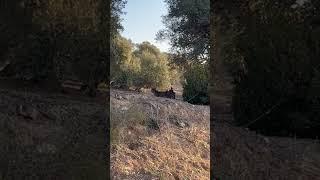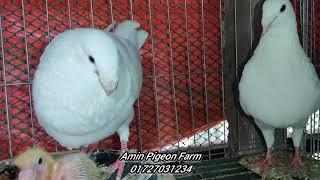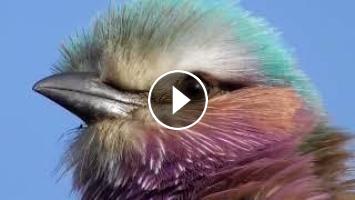Assalam O Alikum!
Welcome to this video..
Lilac breasted roller call
In the African sky, lilac-breasted rollers are true rainbows. This small bird dazzles and hypnotizes viewers with its blue wings, green head, and purple chest. Its scientific name is Coracias caudatus. They got their name from diving down and swooping. This bird is the national bird of Kenya.
In many civilizations, they also hold a wealth of tradition and folklore. The lilac-breasted roller is known as the "peace bird" in African tradition. When kings declared peace in their land, it was frequently sacrificed. It was known as the "bird of the sun".
The lilac-breasted roller is an African member of the roller family of birds. It is widely distributed in sub-Saharan Africa and the southern Arabian Peninsula, preferring open woodland and savanna; it is largely absent from treeless places. Usually found alone or in pairs, it perches conspicuously at the tops of trees, poles or other high vantage points from where it can spot insects, lizards, scorpions, snails, small birds and rodents moving about at ground level.
Nesting takes place in a natural hole in a tree where a clutch of 2–4 eggs is laid, and incubated by both parents, who are extremely aggressive in defense of their nest, taking on raptors and other birds. During the breeding season the male will rise to great heights, descending in swoops and dives, while uttering harsh, discordant cries.
The sexes are alike in coloration. Juveniles do not have the long tail feathers that adults do. In the field, these crow-sized rollers are often perched alone on a tree in a grassy clearing. Lilac-breasted rollers are almost unmistakable with their bright plumage but may be confused with Abyssinian Rollers in Turkana Basin of Kenya. For C. c. caudatus, look for a lilac throat that deepens into a darker lilac breast. The crown to mantle is olive, and the cheeks and ear coverts are a lilac-rufous.
In the subspecies C. c. lorti, the crown to mantle is blue instead of olive, and the breast is azure. The throat is lilac, and some blue-throated rollers have a lilac patch on the lower abdomen. Both subspecies have long black outermost tail feathers that are absent in juveniles. Lilac-breasted rollers are not sexually dimorphic but males may be slightly larger than females. The average mass is 104 grams, and length ranges from 36 to 38 centimeters. These acrobatic fliers have an average wingspan range of 50 to 58 cm. Unique to rollers (Coraciidae family) are syndactyl feet, in which the second and third digits are fused.
The sexes are different in coloration, and juveniles lack the long tail streamers of adults. This species is unofficially considered the national bird of Kenya. Alternative names for the lilac-breasted roller include the fork-tailed roller, lilac-throated roller (also used for a subspecies of purple roller) and Mosilikatze's roller.
The lilac-breasted roller is one of nine species in genus Coracias, a group native to the open woodlands of western Eurasia and Africa. The call of a lilac-breasted roller is a harsh, sawing "rak rak rak" that is given during flight. Usually, the bird will perch to sing.
The diet of the lilac-breasted roller consists of arthropods and small vertebrates, including ground-dwelling insects, spiders, scorpions, centipedes and millipedes, snails, and a variety of small vertebrates, including small birds.
Instagram ➤https://www.instagram.com/nadia_aziz1745/
Facebook Page ➤https://www.facebook.com/nadia.aziz.3192479
Youtube Channel ➤ https://www.youtube.com/channel/UCdTFgWhGV6ZJt_xcltAkK5w
Welcome to this video..
Lilac breasted roller call
In the African sky, lilac-breasted rollers are true rainbows. This small bird dazzles and hypnotizes viewers with its blue wings, green head, and purple chest. Its scientific name is Coracias caudatus. They got their name from diving down and swooping. This bird is the national bird of Kenya.
In many civilizations, they also hold a wealth of tradition and folklore. The lilac-breasted roller is known as the "peace bird" in African tradition. When kings declared peace in their land, it was frequently sacrificed. It was known as the "bird of the sun".
The lilac-breasted roller is an African member of the roller family of birds. It is widely distributed in sub-Saharan Africa and the southern Arabian Peninsula, preferring open woodland and savanna; it is largely absent from treeless places. Usually found alone or in pairs, it perches conspicuously at the tops of trees, poles or other high vantage points from where it can spot insects, lizards, scorpions, snails, small birds and rodents moving about at ground level.
Nesting takes place in a natural hole in a tree where a clutch of 2–4 eggs is laid, and incubated by both parents, who are extremely aggressive in defense of their nest, taking on raptors and other birds. During the breeding season the male will rise to great heights, descending in swoops and dives, while uttering harsh, discordant cries.
The sexes are alike in coloration. Juveniles do not have the long tail feathers that adults do. In the field, these crow-sized rollers are often perched alone on a tree in a grassy clearing. Lilac-breasted rollers are almost unmistakable with their bright plumage but may be confused with Abyssinian Rollers in Turkana Basin of Kenya. For C. c. caudatus, look for a lilac throat that deepens into a darker lilac breast. The crown to mantle is olive, and the cheeks and ear coverts are a lilac-rufous.
In the subspecies C. c. lorti, the crown to mantle is blue instead of olive, and the breast is azure. The throat is lilac, and some blue-throated rollers have a lilac patch on the lower abdomen. Both subspecies have long black outermost tail feathers that are absent in juveniles. Lilac-breasted rollers are not sexually dimorphic but males may be slightly larger than females. The average mass is 104 grams, and length ranges from 36 to 38 centimeters. These acrobatic fliers have an average wingspan range of 50 to 58 cm. Unique to rollers (Coraciidae family) are syndactyl feet, in which the second and third digits are fused.
The sexes are different in coloration, and juveniles lack the long tail streamers of adults. This species is unofficially considered the national bird of Kenya. Alternative names for the lilac-breasted roller include the fork-tailed roller, lilac-throated roller (also used for a subspecies of purple roller) and Mosilikatze's roller.
The lilac-breasted roller is one of nine species in genus Coracias, a group native to the open woodlands of western Eurasia and Africa. The call of a lilac-breasted roller is a harsh, sawing "rak rak rak" that is given during flight. Usually, the bird will perch to sing.
The diet of the lilac-breasted roller consists of arthropods and small vertebrates, including ground-dwelling insects, spiders, scorpions, centipedes and millipedes, snails, and a variety of small vertebrates, including small birds.
Instagram ➤https://www.instagram.com/nadia_aziz1745/
Facebook Page ➤https://www.facebook.com/nadia.aziz.3192479
Youtube Channel ➤ https://www.youtube.com/channel/UCdTFgWhGV6ZJt_xcltAkK5w
- Catégories
- Chats de Race Abyssin
- Mots-clés
- wildlife, nature, birds
















Commentaires